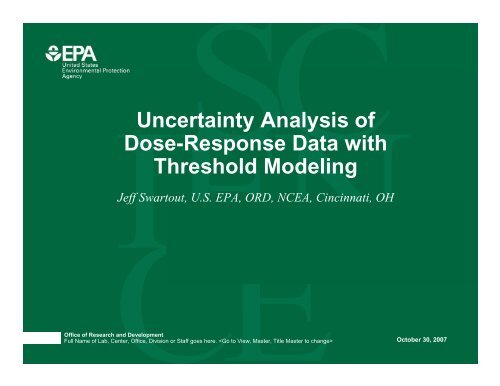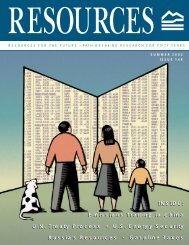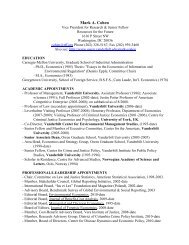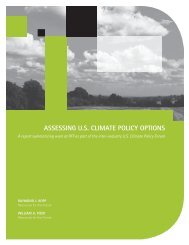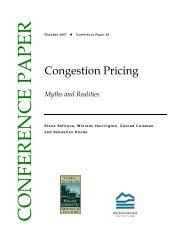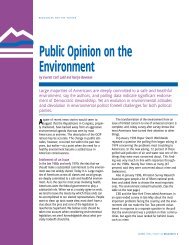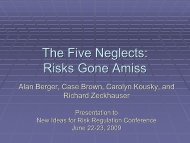Uncertainty Analysis of Dose-Response Data with Threshold Modeling
Uncertainty Analysis of Dose-Response Data with Threshold Modeling
Uncertainty Analysis of Dose-Response Data with Threshold Modeling
Create successful ePaper yourself
Turn your PDF publications into a flip-book with our unique Google optimized e-Paper software.
<strong>Uncertainty</strong> <strong>Analysis</strong> <strong>of</strong><br />
<strong>Dose</strong>-<strong>Response</strong> <strong>Data</strong> <strong>with</strong><br />
<strong>Threshold</strong> <strong>Modeling</strong><br />
Jeff Swartout, U.S. EPA, ORD, NCEA, Cincinnati, OH<br />
Office <strong>of</strong> Research and Development<br />
Full Name <strong>of</strong> Lab, Center, Office, Division or Staff goes here. <br />
October 30, 2007
Purpose and Motivation<br />
• Provide alternative to a non-zero BMR<br />
• Consistency in risk estimates<br />
• Compare threshold vs. non-threshold approaches<br />
1
Population <strong>Threshold</strong> Concept<br />
• Considering only adverse (toxic) effects, such as<br />
functional damage to an organ system or death, in the<br />
extreme, there must be some level <strong>of</strong> exposure, below<br />
which the effect does not occur in any individual (Cox,<br />
1987).<br />
• One molecule may destroy an enzyme or disrupt a<br />
membrane but cannot, by itself, result in functional<br />
damage unless the effect is fixed and heritable.<br />
2
<strong>Threshold</strong> vs. Non-<strong>Threshold</strong><br />
cumulative response<br />
0.0001 0.0010 0.0100 0.1000 1.0000<br />
Rat data<br />
HED extrapolation<br />
Non-threshold fit<br />
<strong>Threshold</strong> fit<br />
RfD<br />
+<br />
+<br />
0.1 1.0 10.0 100.0<br />
dose<br />
3
<strong>Threshold</strong> <strong>Dose</strong>-<strong>Response</strong> Models<br />
• Individual tolerance distributions<br />
– Lognormal, Weibull, log-logistic, etc.<br />
– No population threshold<br />
• Population threshold models<br />
– Tolerance distribution <strong>with</strong> D - T term<br />
– Tukey-lambda family (Cox, 1987)<br />
4
<strong>Threshold</strong> Models<br />
Hill (log-logistic)<br />
Pareto<br />
ED<br />
( D −T<br />
)<br />
N<br />
N<br />
50<br />
+ ( D −<br />
T<br />
)<br />
N<br />
⎛<br />
1− ⎜<br />
T<br />
⎝<br />
α<br />
⎞<br />
⎟<br />
⎠<br />
−α<br />
Weibull<br />
1<br />
−<br />
exp<br />
⎡<br />
⎢−<br />
⎢<br />
⎣<br />
⎛<br />
⎜<br />
⎝<br />
D<br />
−<br />
b<br />
T<br />
⎞<br />
⎟<br />
⎠<br />
c<br />
⎤<br />
⎥<br />
⎥<br />
⎦<br />
D = administered dose<br />
T = threshold dose parameter<br />
N = Hill exponent<br />
C = Weibull power<br />
5
Bootstrap Procedure<br />
• Fit threshold models to raw data<br />
• Select best-fitting model<br />
• Compute “true” response for each dose<br />
– Use non-threshold model fit for zero-response dose<br />
groups<br />
6
Bootstrap Procedure<br />
7<br />
• Generate random binomial response for each dose<br />
group (parametric bootstrap)<br />
– Simulates re-running the experiment at fixed doses<br />
<strong>with</strong> random draws from the same population, given<br />
the true probability <strong>of</strong> response at each dose = p d<br />
– Generates a new response vector (number <strong>of</strong><br />
responders)<br />
• rbinom(n d , p d )<br />
– n d is the number <strong>of</strong> individuals in dose group d<br />
– p d is fitted response to raw data<br />
• Fit all models to bootstrapped response<br />
• Save threshold estimates at each iteration from bestfitting<br />
model
Assumptions and Limitations<br />
• True animal response represented by initial model fit<br />
• <strong>Response</strong> at zero-observed response doses equivalent<br />
to fitted non-threshold response (divided by 2)<br />
• Assumed response distribution valid near threshold<br />
• Binomial uncertainty only<br />
• Constraints on parameter space are ignored<br />
8
Sample Bootstrap Output<br />
(Frambozadrine)<br />
cumulative response<br />
0.001 0.005 0.050 0.500<br />
Hill<br />
Weibull<br />
gamma<br />
lognormal<br />
Pareto<br />
1 5 10 50 100<br />
dose (mg/kg-day)<br />
BMDL 10<br />
<strong>Threshold</strong> fits shown in relation to the BMDL<br />
9<br />
Colors indicate best-fitting model at each iteration (100 shown)
Sample Bootstrap Output<br />
(Mordorine)<br />
cumulative response<br />
0.05 0.10 0.50 1.00<br />
0.001 0.010 0.100 1.000 10.000<br />
BMDL 10<br />
dose<br />
<strong>Threshold</strong> fits shown in relation to the BMDL<br />
10<br />
Colors indicate best-fitting model at each iteration (100 shown)
Sample Bootstrap <strong>Threshold</strong><br />
Distributions<br />
0 1 2 3 4 5 6<br />
0.0 0.5 1.0 1.5 2.0<br />
0.0 0.5 1.0 1.5 2.0<br />
<strong>Threshold</strong> (log10 mg/kg-day)<br />
-2.0 -1.5 -1.0 -0.5 0.0 0.5 1.0<br />
<strong>Threshold</strong> (log10 mg/kg-day)<br />
0.0 0.2 0.4 0.6 0.8 1.0<br />
-4 -3 -2 -1 0 1<br />
<strong>Threshold</strong> (log10 mg/kg-day)<br />
0.0 0.2 0.4 0.6 0.8 1.0 1.2<br />
-3 -2 -1 0 1<br />
<strong>Threshold</strong> (log10 mg/kg-day)<br />
11
Frambozadrine<br />
cumulative response<br />
0.0 0.2 0.4 0.6 0.8 1.0<br />
Weibull (BMD)<br />
Weibull threhsold<br />
BMDL---BMD<br />
T05---Tml<br />
5 10 50 100<br />
dose (mg/kg-day)<br />
12
Frobozinate<br />
cumulative response<br />
0.0 0.2 0.4 0.6 0.8 1.0<br />
log-logistic (BMD)<br />
Pareto<br />
BMDL---BMD<br />
T05---Tml<br />
0.1 0.5 1.0 5.0 10.0 50.0 100.0<br />
dose (mg/kg-day)<br />
13
Gruesite<br />
cumulative response<br />
0.0 0.2 0.4 0.6 0.8 1.0<br />
log-logistic (BMD)<br />
Pareto<br />
BMDL---BMD<br />
T05---Tml<br />
10^-4 10^-3 10^-2 10^-1 10^0 10^1 10^2 10^3<br />
dose (mg/kg-day)<br />
14
Phluginium<br />
cumulative response<br />
0.0 0.2 0.4 0.6 0.8 1.0<br />
log-normal (BMD)<br />
log-normal threhsold<br />
BMDL---BMD<br />
T05---Tml<br />
0.5 1.0 5.0 10.0 50.0<br />
dose (mg/kg-day)<br />
15
Mordorene<br />
cumulative response<br />
0.0 0.2 0.4 0.6 0.8 1.0<br />
Weibull (BMD)<br />
Pareto<br />
BMDL---BMD<br />
T05---Tml<br />
0.01 0.10 1.00 10.00<br />
dose (mg/kg-day)<br />
16
Neelixir<br />
cumulative response<br />
0.0 0.2 0.4 0.6 0.8 1.0<br />
Weibull (BMD)<br />
Weibull threhsold<br />
BMDL---BMD<br />
Tml<br />
0.1 1.0 10.0 100.0<br />
dose (mg/kg-day)<br />
17
Summary <strong>of</strong> Results<br />
Compound<br />
Weibull<br />
Power<br />
BMDL 10<br />
a<br />
TL b<br />
BMDLr c<br />
TLr d<br />
TL: BMDL<br />
Frambozadrine<br />
1.4<br />
24.6<br />
4.45<br />
1.7<br />
4.8<br />
0.18<br />
Frobozinate<br />
0.34<br />
0.10<br />
0.091<br />
3.0<br />
11<br />
0.91<br />
Gruesite<br />
0.35<br />
5.7 x 10 -5<br />
0.27<br />
2940<br />
3.7<br />
4780<br />
Phluginium<br />
0.83<br />
1.89<br />
0.19<br />
1.2<br />
5.1<br />
0.10<br />
Mordorene<br />
0.86<br />
0.0027<br />
0.030<br />
217<br />
33<br />
11<br />
Neelixir<br />
1.5<br />
18.1<br />
0<br />
0.25<br />
–<br />
0.22 e<br />
a<br />
95% lower confidence bound on BMD 10 (BMDS)<br />
b<br />
95% lower confidence bound on threshold (bootstrap)<br />
c<br />
Ratio <strong>of</strong> BMDMLE to BMDL<br />
d<br />
Ratio <strong>of</strong> TMLE to TL<br />
e<br />
TMLE : BMDMLE<br />
18
19<br />
That’s All<br />
Weibull (BMD)<br />
Weibull threhsold<br />
BMDL---BMD<br />
T05---Tml<br />
Hill<br />
Weibull<br />
gamma<br />
lognormal<br />
Pareto<br />
5 10 50 100<br />
dose (mg/kg-day)<br />
dose (mg/kg-day)<br />
0.0 0.5 1.0 1.5 2.0<br />
cumulative response<br />
0.0 0.2 0.4 0.6 0.8 1.0<br />
Probability density<br />
0 1 2 3 4 5 6<br />
cumulative response<br />
0.001 0.005 0.050 0.500<br />
1 5 10 50 100<br />
<strong>Threshold</strong> (log10 mg/kg-day)


